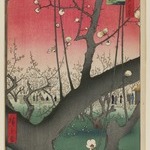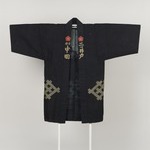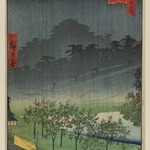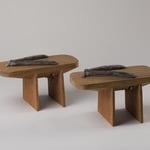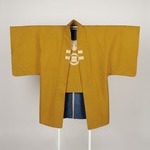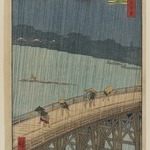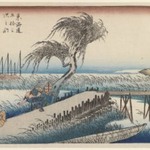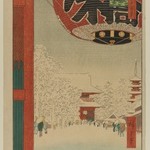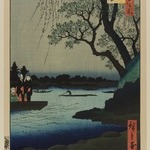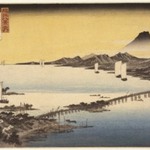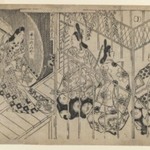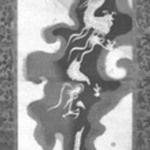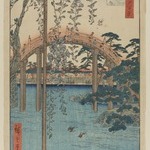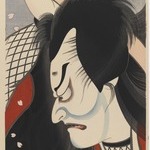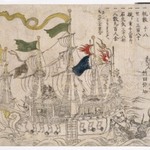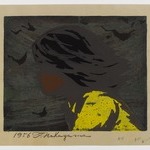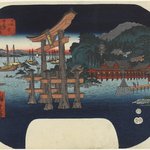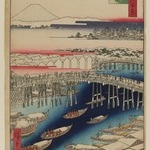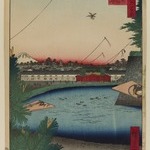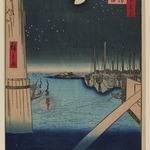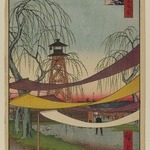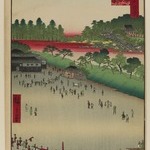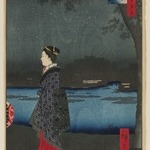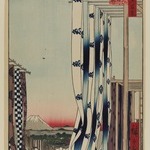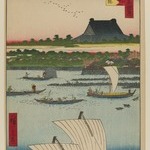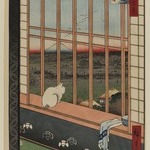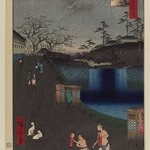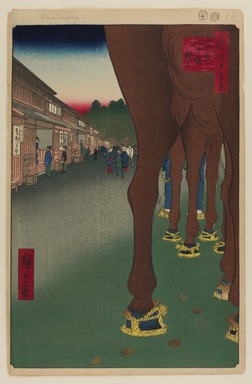
Naito Shinjuku, Yotsuya, No. 86 from One Hundred Famous Views of Edo
Utagawa Hiroshige
Asian Art
Why would the artist choose such an odd vantage point? The lowness of the subject matter, apart from the hind view, is important in considering this print in context; it is an appropriate expression of the place: Naitō Shinjuku, near Yotsuya Gate, the western entrance to Edo. Founded in 1698, this quarter was intended from the start as a semiofficial center of prostitution and the first stop along Kōshū Highway out of Edo. The prostitutes at this down-to-earth settlement were described as "flowers blooming in the horse droppings of Yotsuya." Hiroshige pays close attention to the placement of the objects on the ground, from the straw-sandaled legs of the two horses and their groom to the five separate balls of manure.
MEDIUM
Woodblock print
DATES
11th month of 1857
PERIOD
Edo Period, Ansei Era
DIMENSIONS
Sheet: 14 3/16 x 9 1/4 in. (36 x 23.5 cm)
Image: 13 3/8 x 8 3/4 in. (34 x 22.2 cm) (show scale)



MARKINGS
No publisher's seal visible, probably lost when left margin was trimmed. Date seal and censor seal at top margin.
SIGNATURE
Hiroshige-ga
COLLECTIONS
Asian Art
ACCESSION NUMBER
30.1478.86
CREDIT LINE
Gift of Anna Ferris
PROVENANCE
Prior to 1930, provenance not yet documented; by 1930, acquired by Anna Ferris of Summit, NJ; 1930, gift of Anna Ferris to the Brooklyn Museum.
Provenance FAQ
CATALOGUE DESCRIPTION
Both European and Japanese observers have objected to this print due to the lowness of its subject matter. It can also be argued that it is in fact an "appropriate expression of the place." (H. Smith, in Braziller, N.Y. 1986) Naito Shinjuku was founded in 1698 by a group of Yoshiwara brothel owners and was intended from the start as a semiofficial center of prostitution, like Shinagawa Senju and Itabashi, the other stops along the major highways out of town. Shinjuku was named after the daimyo whose estate was reduced in size to make room for it. It was closed in 1718 after a samurai brawl and reopened in 1782, after which time it became most profitable. The artist has offered a detailed view, not only of the butt of the horse and its scattered droppings but also of the straw sandaled hooves of the horses. The trees beyond surround the guard station at the terminus of the Tamagawa Canal, next to Yotsuya Gate, the entrance to Edo from the west. Today, Shinjuku Station is one of the world's largest rail terminals, serving more than a million passengers daily. The huge skyscraper development just west of the station is the location of Tokyo's new City Hall.
EXHIBITIONS
MUSEUM LOCATION
This item is not on view
CAPTION
Utagawa Hiroshige (Japanese, 1797–1858). Naito Shinjuku, Yotsuya, No. 86 from One Hundred Famous Views of Edo, 11th month of 1857. Woodblock print, Sheet: 14 3/16 x 9 1/4 in. (36 x 23.5 cm). Brooklyn Museum, Gift of Anna Ferris, 30.1478.86 (Photo: Brooklyn Museum, 30.1478.86_PS20.jpg)
IMAGE
overall, 30.1478.86_PS20.jpg. Brooklyn Museum photograph, 2023
"CUR" at the beginning of an image file name means that the image was created by a curatorial staff member. These study images may be digital point-and-shoot photographs, when we don\'t yet have high-quality studio photography, or they may be scans of older negatives, slides, or photographic prints, providing historical documentation of the object.
RIGHTS STATEMENT
No known copyright restrictions
This work may be in the public domain in the United States. Works created by United States and non-United States nationals published prior to 1923 are in the public domain, subject to the terms of any applicable treaty or agreement.
You may download and use Brooklyn Museum images of this work. Please include caption information from this page and credit the Brooklyn Museum. If you need a high resolution file, please fill out our online application form (charges apply).
The Museum does not warrant that the use of this work will not infringe on the rights of third parties, such as artists or artists' heirs holding the rights to the work. It is your responsibility to determine and satisfy copyright or other use restrictions before copying, transmitting, or making other use of protected items beyond that allowed by "fair use," as such term is understood under the United States Copyright Act.
The Brooklyn Museum makes no representations or warranties with respect to the application or terms of any international agreement governing copyright protection in the United States for works created by foreign nationals.
For further information about copyright, we recommend resources at the United States Library of Congress, Cornell University, Copyright and Cultural Institutions: Guidelines for U.S. Libraries, Archives, and Museums, and Copyright Watch.
For more information about the Museum's rights project, including how rights types are assigned, please see our blog posts on copyright.
If you have any information regarding this work and rights to it, please contact copyright@brooklynmuseum.org.
RECORD COMPLETENESS
Not every record you will find here is complete. More information is available for some works than for others, and some entries have been updated more recently. Records are frequently reviewed and revised, and we welcome any additional information you might have.
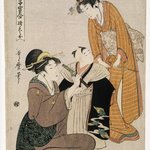
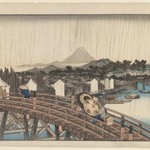
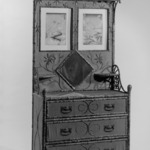



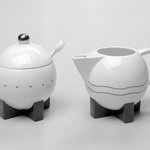

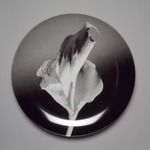

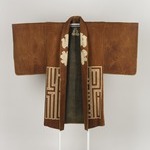
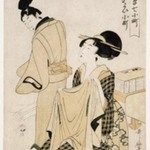
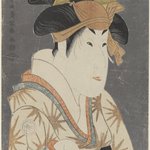

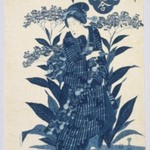
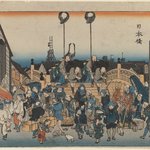
![Kakinomoto no Hitomaro [missing title cartouche: Children Parody the Six Immortal Poets (Tosei Kodomo Rokkasen)]](https://d1lfxha3ugu3d4.cloudfront.net/images/opencollection/objects/size2_sq/82.191_print_IMLS_SL2.jpg)
